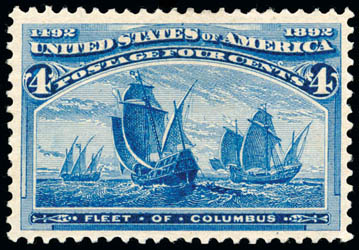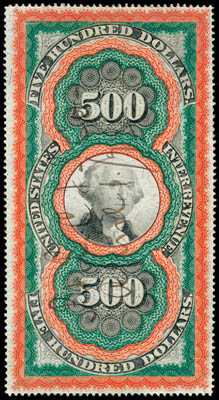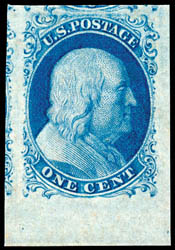
Lot 1909 o
1851, 1¢ blue, type I, neat central circular grid cancellation, wide margins showing portions of adjacent stamps at sides with scrolls at right just shaving at top and bottom, rich distinctive plate one early color, completely sound and fault-free, Very Fine, in the P.S.E. Population Report, this is the only example to be awarded this grade with only two examples that are higher (both 90J), Scott catalog value for examples with margins touching or cutting slightly into design or for four margin examples with minor faults; with 2007 P.S.E. Graded certificate (VF 80, SMQ $160,000).Scott No. 5 $70,000.
A REMARKABLE AND RARE SOUND EXAMPLE OF THE 1¢ TYPE I IMPERFORATE, CLEARLY SHOWCASING THE TYPE I CHARACTERISTICS. CERTAINLY AMID THE FINEST SOUND EXAMPLES EXTANT.
Accompanied by note from P.S.E. master grader, Bill Litle, comparing and equating this stamp to the Hinrichs copy (which sold at the Siegel 2007 Scarsdale Collection sale for $375,000 hammer) and reads…"The Hinrichs stamp was well clear top and bottom, touching at left. This one very wide left and right but slightly cutting at top right and bottom right. The SMQ listing for VF80 was for the ex Hinrichs stamp (never actually graded, just estimated).". This example was never recorded in the Wagshal census.

Lot
2670 
Postal Card, 1920, 1¢ on 2¢ red on cream, clear surcharge, cancelled by "Long Beach Calif. Mar 21 1921" way machine cancel to local address, back of card with Long Beach Public Library notice notifying recipient that his book is reserved until Mar. 24, small light creases at top center and bottom, Very Fine, ex-Falberg; with 2006 P.F. certificate. Scott No. UX36 $75,000.
THOUGHT TO BE THE FINEST OF ONLY THREE CONFIRMED EXAMPLES OF THE ERROR SURCHARGE ON THE 1911 2¢ GRANT INTERNATIONAL POSTAL CARDS. THE KEY ITEM IN THE FIELD OF POSTAL CARD COLLECTING.
As part of the postal rate increases that were put in place to help fund World War I, the domestic postal card rate was increased from 1¢ to 2¢. New 2¢ Jefferson cards (Scott UX29 and UX30) were created to meet this rate. When the war ended, prewar rates were restored, including the 1¢ card rate. In at least 46 cities, leftover 2¢ cards were subsequently surcharged "1 cent" using special revaluing dies that were fitted into local canceling machines. The country was being flooded with with revalued postal cards from many different cities and dies, but a few examples of genuine error entered the mail stream from the Los Angeles post office, where the 1¢ surcharge was applied not just to the proper 2¢ Jefferson cards, but also to a few copies of the 2¢ Grant international card of 1911. The card offered here was discovered in 1992 by an auction describer in a balance lot that the owner had suggested contained nothing but junk, and last sold in 2010 for the record price of $109,250.
The four recorded examples including the unconfirmed:
1. Mar. 21, 1921. Long Beach Cal. to local city address. Long Beach Library notice, ex-Falberg, the card offered here.
2. Mar. 22, 1921. Long Beach Cal. to local city address. Long Beach Library notice, ex-Clark H. Stevens, Scarsdale.
3. 1921, Elk Club notice, ex-Dr. Mitchell
4. 1921, Elks Club notice, discovery copy by Elks Club member, perhaps discarded and lost to philately as not seen since 1923.
Realized: $80,000

Lot
2210 
1893, 4¢ Columbian, blue color error, o.g., lightly hinged, choice centering amid nicely balanced margins, deep intense color on fresh paper, Extremely Fine; with 1962, 1998 P.F. certificates and 2004 P.S.E. Graded certificate (XF 90, SMQ $40,000). Scott No. 233a $17,500.
A WONDERFULLY CHOICE MINT EXAMPLE OF THE 4¢ COLUMBIAN ERROR OF COLOR. THE HIGHEST AWARD GRADED EXAMPLE IN BOTH MINT OR USED CONDITION.
The 4¢ Columbian color error was a result of using the blue ink intended for the 1¢ Columbian value. At least two sheets where printed coming from plates D17 and D18 (the plate numbers from these sheets still exist) with very few examples, both mint and used, surviving from these printings. It should be noted that many of the survivors are of inferior condition and centering, with only a few examples of exceptional nature.

Lot
285 

France, 1870, Siege of Paris, 20c dull blue on bluish, tête-bêche, an eye-arresting mint block of nine, the center stamp the inverted cliche, exceedingly well centered throughout, lovely bright shade, strong intact perforations all around, full original gum, top left, top right and bottom center stamps h.r., the others, including the tête-bêche pair are never hinged, Extremely Fine and choice, ex-"Lafayette", Gross; signed Bernard and Pascal Behr, J.F. Brun, Calves and Goebel, as well as being accompanied by 2003 Behr, Brun and Goebel certificates. Maury Nos. 37b tb. Scott Nos. 57b Estimate $35,000 - 40,000.
CERTAINLY THE FINEST TÊTE-BÊCHE MULTIPLE OF THE 20C 1870 SIEGE OF PARIS ISSUE AVAILABLE.
Most inverted cliches are found in tete-beche pairs, to find one in this eye-appealing format at the center of a block of nine is a rare occurrence indeed.

Lot
102 

Falkland Islands, 1964, 6d "H.M.S. Glasgow" Vignette Error, o.g., never hinged, well centered, bright vibrant colors and exceptional freshness, Extremely Fine. Scott Nos. 151a. SG Nos. 216a £40,000 ($64,740).
A WONDERFUL NEVER HINGED EXAMPLE OF THIS POPULAR MAJOR 20TH CENTURY FALKLAND ISLANDS RARITY.
When the error first came onto the market, it was first discovered by a North American collector in 1970. The owner had acquired the set in 1965 and noticed the Glasgow vignette on the two values yet believed at the time it to be normal. It was not until later, after reading an article in a British philatelic magazine, that he realized that the stamp was a major error. It is believed that only one sheet of 60 of this famous error had been produced. A note in the Stanley Gibbons catalog regarding this stamp states: "There have been seventeen reports of stamps showing this error, although it is believed that some of these may refer to the same example.".
Realized: $40,000

Lot 2697 o
Documentary, 1871, Second Issue, $500 "Persian Rug", manuscript 1872 year date cancellation, well centered with full perforation teeth around, colors rich and vibrant, Very Fine, a rare sound example, Scott catalog value for a very fine appearing example with light cut cancel or minor flaws, ex Weill; with 1989 P.F. and 2014 P.S.E. certificates.Scott No. R133 $17,500.
A WONDERFUL EXAMPLE OF THE $500 PERSIAN RUG ISSUE, ONE OF THE FEW COMPLETELY SOUND EXAMPLES IN EXISTENCE.

Lot
1912 
1851, 1¢ blue, type II, Plate 3, bottom margin single, o.g., lightly hinged, full bottom sheet margin with huge margins around encompassing portions of adjacent stamps at top and left, rich bold color and sharp detail impression, a Superb jumbo gem, awarded by the Philatelic Foundation the highest grade attainable; with 2011 P.F. Graded certificate (Sup Gem 100J). Scott No. 7 $9,000.
A PHENOMENAL MINT ORIGINAL GUM EXAMPLE OF THE VERY SCARCE 1856 1¢ TYPE II IMPERFORATE FROM PLATE 3. WITHOUT QUESTION, THE FINEST MINT EXAMPLE IN EXISTENCE.
The 1¢ stamps from Plate 3 where produced in the early spring of 1856, likely due to the compulsory prepayment of postage that was introduced after April 1st of 1855 and an increased demand for the 1¢ value. Also Plate 2, that was in production at the time, had a large plate flaw and there may have been concerns that the plate would deteriorate to a point that it would have to be withdrawn. There is no evidence why Plate 3 had a short life, but it assumed that due to numerous surface cracks developing during it's use that this was the main reason that the plate was deemed unfit for use.

Lot
2307 
1901, 4¢ Pan-American, center inverted, full o.g., well centered amid wide margins, strong vivid colors, reperforated at top, Very Fine to Extremely Fine appearance; with 1999 P.F. certificate. Scott No. 296a $75,000.
AN ATTRACTIVE EXAMPLE OF THE 4¢ PAN-AMERICAN WITH CENTER INVERTED. A GREAT 20TH CENTURY RARITY.
The 4¢ invert was printed deliberately as the result of a misunderstanding. After the discovery of the 1¢ and 2¢ inverts in mid-1901, the Third Assistant Postmaster, Edwin C. Madden, decided to track down any additional errors. He had his assistant instruct the Bureau of Engraving and Printing to send any inverted Pan-American stamps to Madden's office. No inverted stamps in fact remained on hand, and interpreting Madden's communique as an unconditional demand for inverts, the Bureau produced four sheets of them from the 4 cent plates and sent 400 copies on to Madden. About about half were marked "Specimen" and between 1901 and 1904 Madden distributed 172 examples.

Lot
728 
Wells Fargo & Co., 1861, $2 red, large margins except just touched at top, rich color, tied by blue "Wells Fargo & Co., Placerville, May 2" oval datestamp on 10c green on buff Star Die entire (U33) with Wells, Fargo & Co. red printed frank addressed to J.W. Smith at Tuscola Ill., partial green "St. Joseph Mo. May 14" cds applied on arrival and entry into the mail system; restored at right edge, Very Fine appearance, ex-Lichtenstein. Scott No. 143L1 Estimate $15,000 - 20,000.
A BEAUTIFUL EASTBOUND PONY EXPRESS COVER WITH THE WELLS, FARGO & COMPANY $2.00 HORSE & RIDER ISSUE. THE FINER OF ONLY TWO RECORDED $2.00 WAY USAGES FROM PLACERVILLE.
The rate was $2 per ½ ounce from April 1, 1861 until June 30, 1861 when the Pony Express was run by Wells Fargo & Co. and not the Central Overland California & Pikes Peak Express Company. Pony Express mail from Placerville is rare compared to those originating the in the San Francisco or Sacramento Pony Express offices. Mails collected at stations along the route between San Francisco and St. Joseph is term "way" mail. Way mail was accounted for, and carried, separately from the other mails with each letter entered on a way bill that was updated as additional letters were collected. At St. Joseph, the pony mail was turned into the St. Joseph post office for onward transmission by the government postal system. St. Joseph was the terminus for the Hannibal and St. Joseph Railroad, from whence there was rapid mail connection to the east.
Realized: $18,000

Lot 205 o
China, 1912, Nanking "Provisional Neutrality" overprint, $5 green & salmon, town cancel, strong colors, Very Fine, ex-Sir Percival David; signed Senf, Grobe, with 2010 China Stamp Society certificate.Scott Nos. 145 $10,000.
A LOVELY AND VERY RARE USED EXAMPLE OF THIS HIGH VALUE NANKING ISSUE. WITH ONLY 32 REPORTED TO BE ISSUED.
Realized: $11,500
